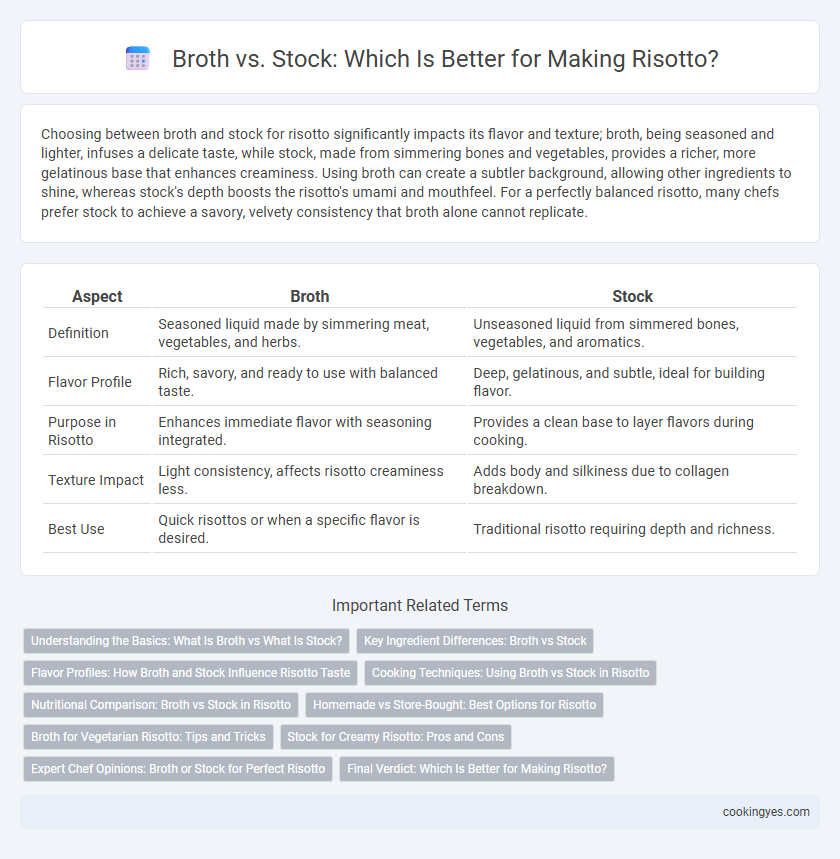Choosing between broth and stock for risotto significantly impacts its flavor and texture; broth, being seasoned and lighter, infuses a delicate taste, while stock, made from simmering bones and vegetables, provides a richer, more gelatinous base that enhances creaminess. Using broth can create a subtler background, allowing other ingredients to shine, whereas stock's depth boosts the risotto's umami and mouthfeel. For a perfectly balanced risotto, many chefs prefer stock to achieve a savory, velvety consistency that broth alone cannot replicate.
Table of Comparison
| Aspect | Broth | Stock |
|---|---|---|
| Definition | Seasoned liquid made by simmering meat, vegetables, and herbs. | Unseasoned liquid from simmered bones, vegetables, and aromatics. |
| Flavor Profile | Rich, savory, and ready to use with balanced taste. | Deep, gelatinous, and subtle, ideal for building flavor. |
| Purpose in Risotto | Enhances immediate flavor with seasoning integrated. | Provides a clean base to layer flavors during cooking. |
| Texture Impact | Light consistency, affects risotto creaminess less. | Adds body and silkiness due to collagen breakdown. |
| Best Use | Quick risottos or when a specific flavor is desired. | Traditional risotto requiring depth and richness. |
Understanding the Basics: What Is Broth vs What Is Stock?
Broth is a flavorful liquid made by simmering meat, vegetables, and sometimes bones, providing a lighter taste ideal for risotto. Stock is richer and more gelatinous, primarily derived from bones and simmered longer to extract collagen, enhancing the dish's depth and texture. Choosing broth or stock impacts the risotto's flavor intensity and creaminess, essential for achieving the perfect balance in traditional recipes.
Key Ingredient Differences: Broth vs Stock
Broth is a flavored liquid made by simmering meat, vegetables, and seasonings, providing a lighter, more delicate taste to risotto. Stock, derived primarily from simmered bones and connective tissue, offers a richer, gelatinous texture that enhances the risotto's depth and mouthfeel. Choosing broth emphasizes flavor clarity, while stock adds body and umami, impacting the overall risotto consistency and taste profile.
Flavor Profiles: How Broth and Stock Influence Risotto Taste
Broth imparts a lighter, more distinct flavor to risotto, often seasoned with herbs and vegetables that complement the creamy rice texture. Stock, simmered longer with bones and connective tissues, delivers a richer, deeper umami taste that enhances the dish's savory complexity. Choosing broth results in a delicate flavor profile, while stock adds robustness and intensity to risotto.
Cooking Techniques: Using Broth vs Stock in Risotto
Using broth in risotto provides a seasoned base that enhances flavor complexity, as it is typically seasoned and ready to use, allowing for immediate flavor integration during the gradual liquid absorption process. Stock offers a richer, deeper mouthfeel due to its higher gelatin content from simmered bones, benefiting risotto by delivering a velvety texture and body that coats the rice grains effectively. Choosing broth accelerates cooking time with balanced seasoning, while stock requires careful seasoning adjustments but yields a more luxurious and robust risotto consistency.
Nutritional Comparison: Broth vs Stock in Risotto
Broth used in risotto generally has a lighter nutritional profile with fewer calories and less fat compared to stock, which is richer in collagen and minerals due to longer simmering of bones. Stock contributes additional proteins and gelatin that enhance the creaminess and mouthfeel of risotto while providing essential nutrients like calcium and magnesium. Choosing broth results in a more delicate flavor with lower sodium content, whereas stock offers a more robust taste and increased nutrient density beneficial for gut health.
Homemade vs Store-Bought: Best Options for Risotto
Homemade broth offers rich, complex flavors from simmered bones and vegetables, enhancing risotto's depth, whereas store-bought options provide convenience but often lack the nuanced taste essential for authentic risotto. Using homemade stock allows precise control over salt and seasoning, ensuring a balanced and creamy texture in the final dish. For the best risotto, choosing a well-prepared homemade broth significantly elevates flavor profiles compared to generic store-bought stocks.
Broth for Vegetarian Risotto: Tips and Tricks
Using broth instead of stock for vegetarian risotto enhances flavor without relying on animal products, with vegetable broth offering a rich, aromatic base that complements the creamy texture of arborio rice. Opt for homemade vegetable broth infused with herbs like thyme, garlic, and onion to add depth and complexity while controlling sodium levels. Gradually adding warm broth during the cooking process ensures even absorption and a perfectly creamy consistency essential for authentic risotto.
Stock for Creamy Risotto: Pros and Cons
Using stock for risotto enhances the creamy texture and deepens the flavor profile, as it is simmered with bones and vegetables, extracting rich gelatin and nutrients. However, stocks can be more time-consuming to prepare and may have higher sodium levels, which require careful seasoning adjustments. Despite these challenges, stock's richness contributes to a velvety consistency that is essential for authentic, luxurious risotto dishes.
Expert Chef Opinions: Broth or Stock for Perfect Risotto
Expert chefs emphasize using broth over stock for risotto because broth offers a clearer, more nuanced flavor that enhances the rice's delicate texture. Broth's balanced seasoning provides a refined depth, avoiding the heaviness that stock sometimes imparts, which can overwhelm the dish. High-quality chicken or vegetable broth is preferred to infuse each grain of Arborio rice with a subtle, layered taste essential for authentic risotto.
Final Verdict: Which Is Better for Making Risotto?
Broth offers a lighter, more nuanced flavor that allows the delicate rice to shine, making it ideal for subtle risotto dishes. Stock, rich in gelatin and minerals from simmered bones, provides a deeper, more robust base that enhances the creamy texture and complexity of heartier risottos. For classic risotto, broth is preferred when aiming for balanced flavors, while stock is better suited for recipes requiring a richer mouthfeel and intensified taste.
Broth vs Stock for Risotto Infographic

 cookingyes.com
cookingyes.com